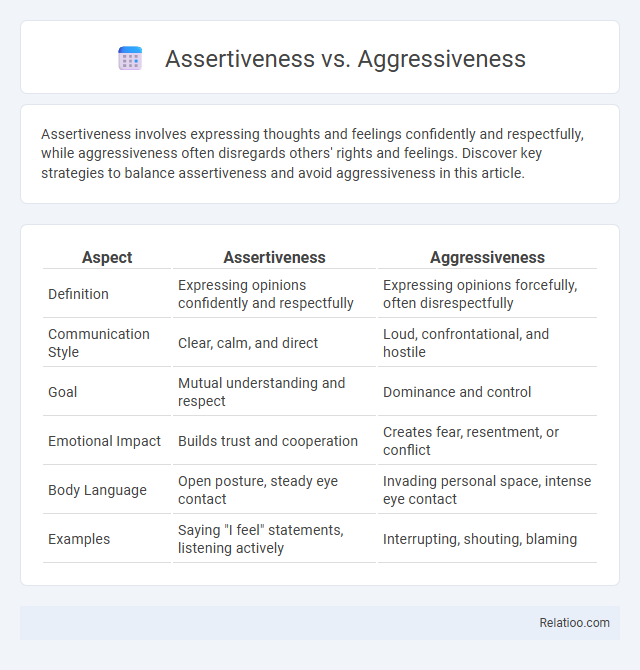Assertiveness involves expressing thoughts and feelings confidently and respectfully, while aggressiveness often disregards others' rights and feelings. Discover key strategies to balance assertiveness and avoid aggressiveness in this article.
Table of Comparison
| Aspect | Assertiveness | Aggressiveness |
|---|---|---|
| Definition | Expressing opinions confidently and respectfully | Expressing opinions forcefully, often disrespectfully |
| Communication Style | Clear, calm, and direct | Loud, confrontational, and hostile |
| Goal | Mutual understanding and respect | Dominance and control |
| Emotional Impact | Builds trust and cooperation | Creates fear, resentment, or conflict |
| Body Language | Open posture, steady eye contact | Invading personal space, intense eye contact |
| Examples | Saying "I feel" statements, listening actively | Interrupting, shouting, blaming |
Understanding Assertiveness and Aggressiveness
Assertiveness involves expressing thoughts and feelings confidently and respectfully, promoting healthy communication and mutual understanding. Aggressiveness, in contrast, disregards others' rights and emotions, often leading to conflict and damaged relationships. Understanding the differences between assertiveness and aggressiveness is crucial for effective interpersonal interactions and maintaining emotional balance.
Key Differences Between Assertive and Aggressive Behavior
Assertive behavior involves confidently expressing your needs and opinions while respecting others' boundaries, promoting clear and respectful communication. Aggressive behavior, in contrast, disregards others' feelings and rights, often leading to hostility and conflict. Understanding these key differences helps you maintain healthy relationships and effectively advocate for yourself without causing harm.
The Psychology Behind Assertiveness
Assertiveness is a communication style rooted in self-confidence and respect, allowing individuals to express their thoughts and feelings clearly without infringing on others. The psychology behind assertiveness involves understanding one's rights, managing emotions, and maintaining healthy boundaries to promote mutual respect and effective interaction. Unlike aggressiveness, which often stems from anger and aims to dominate or control, assertiveness fosters empowerment and constructive dialogue essential for psychological well-being.
Signs of Assertive Communication
Assertive communication is characterized by clear, direct expression of thoughts and feelings while respecting others' rights, marked by calm tone, steady eye contact, and open body language. Signs include using "I" statements, maintaining a balanced posture, and active listening without interrupting, distinguishing it from aggressiveness, which involves hostile or dominating behavior. Unlike passiveness, assertiveness promotes mutual respect and effective problem-solving through honest and confident dialogue.
Indicators of Aggressive Communication
Indicators of aggressive communication include hostile tone, interrupted speech, and dismissive body language, signaling dominance rather than collaboration. Your interactions may become confrontational, with a focus on winning arguments instead of resolving issues constructively. Recognizing these signs helps differentiate aggressive behavior from assertiveness, where clear, respectful expression is maintained.
Benefits of Being Assertive
Being assertive enhances communication by promoting clarity and respect in expressing ideas, which fosters stronger interpersonal relationships and reduces misunderstandings. Unlike aggressiveness, assertiveness balances confidence with empathy, leading to effective conflict resolution and increased self-esteem. Embracing assertiveness empowers individuals to advocate for their rights while maintaining positive social dynamics and professional growth.
Consequences of Aggressiveness in Relationships
Aggressiveness in relationships often leads to communication breakdowns, increased conflict, and emotional distress, damaging trust and intimacy between partners. Unlike assertiveness, which fosters respect and clear expression of needs, aggressiveness provokes defensiveness and resentment, escalating disputes. Long-term consequences may include weakened emotional bonds and potential relationship dissolution due to unresolved hostility.
Tips to Develop Assertiveness Skills
To develop assertiveness skills, prioritize clear and respectful communication that expresses your needs without violating others' rights. Practice using "I" statements to convey your feelings confidently and maintain calm body language to reinforce your message. Build your assertiveness by setting boundaries consistently and seeking feedback from trusted individuals to improve your interpersonal interactions.
Overcoming Aggressive Tendencies
Overcoming aggressive tendencies requires cultivating assertiveness, which involves expressing your thoughts and feelings confidently without violating others' rights. Assertiveness builds respectful communication and mutual understanding, whereas aggressiveness often triggers conflict and damages relationships. By practicing active listening and maintaining calm body language, you transform confrontational impulses into constructive dialogue.
Assertiveness vs Aggressiveness: Real-Life Examples
Assertiveness involves expressing thoughts and feelings calmly and respectfully, such as calmly stating a need for a deadline extension at work. Aggressiveness manifests through hostile or demanding behavior, like yelling at a colleague to meet unrealistic expectations. Real-life examples highlight assertiveness as a means to foster mutual respect and clear communication, while aggressiveness often results in conflict and damaged relationships.

Infographic: Assertiveness vs Aggressiveness
 relatioo.com
relatioo.com